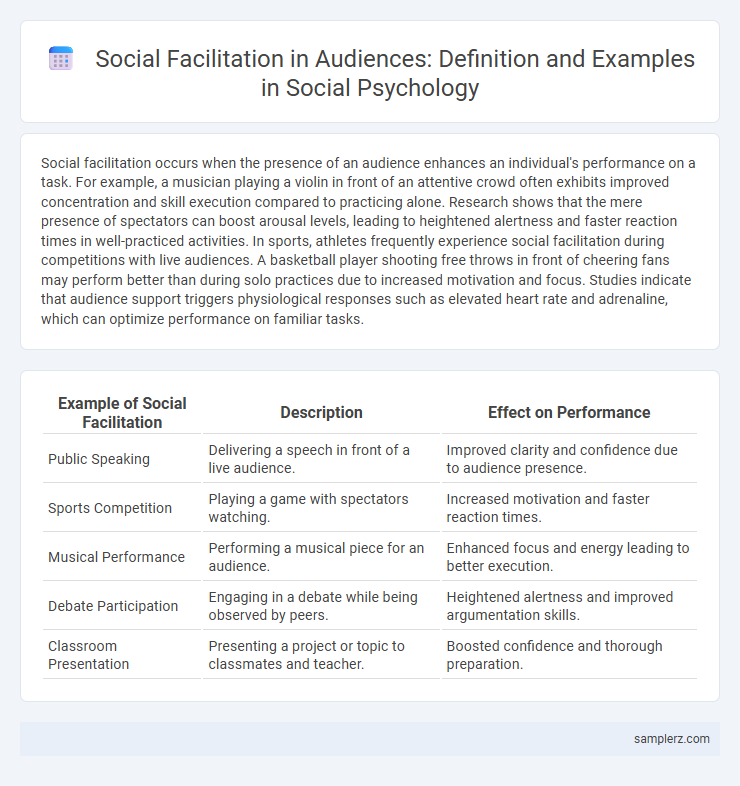Social facilitation occurs when the presence of an audience enhances an individual's performance on a task. For example, a musician playing a violin in front of an attentive crowd often exhibits improved concentration and skill execution compared to practicing alone. Research shows that the mere presence of spectators can boost arousal levels, leading to heightened alertness and faster reaction times in well-practiced activities. In sports, athletes frequently experience social facilitation during competitions with live audiences. A basketball player shooting free throws in front of cheering fans may perform better than during solo practices due to increased motivation and focus. Studies indicate that audience support triggers physiological responses such as elevated heart rate and adrenaline, which can optimize performance on familiar tasks.
Table of Comparison
| Example of Social Facilitation | Description | Effect on Performance |
|---|---|---|
| Public Speaking | Delivering a speech in front of a live audience. | Improved clarity and confidence due to audience presence. |
| Sports Competition | Playing a game with spectators watching. | Increased motivation and faster reaction times. |
| Musical Performance | Performing a musical piece for an audience. | Enhanced focus and energy leading to better execution. |
| Debate Participation | Engaging in a debate while being observed by peers. | Heightened alertness and improved argumentation skills. |
| Classroom Presentation | Presenting a project or topic to classmates and teacher. | Boosted confidence and thorough preparation. |
Introduction to Social Facilitation in Audience Settings
Social facilitation in audience settings occurs when the presence of an audience improves an individual's performance on simple or well-practiced tasks. For instance, a musician playing a familiar piece tends to perform better during a live concert due to increased arousal and motivation. This phenomenon highlights how social presence can enhance task execution by intensifying focus and effort.
Classic Examples of Social Facilitation with Live Audiences
In classic examples of social facilitation, musicians performing in front of live audiences often experience enhanced arousal that boosts their performance on well-rehearsed pieces but may impair complex or new tasks. Studies such as those by Norman Triplett demonstrated cyclists racing faster when competing against others rather than alone, illustrating the audience's impact on performance. Similarly, actors delivering monologues in theater often perform more confidently and energetically with a live audience present, highlighting the influence of social presence.
Sports Performance Enhanced by Spectators
The presence of an enthusiastic crowd significantly boosts athletes' performance by increasing arousal and motivation, a core principle of social facilitation. Research shows that athletes often achieve faster sprint times and higher scores during competitions with lively audiences compared to practice sessions. This enhanced performance is attributed to the heightened focus and energy triggered by spectator presence, demonstrating the powerful impact of social environments on sports outcomes.
Musical Performance Improvements with Audience Presence
Musicians often experience enhanced performance quality when playing before a live audience, demonstrating the phenomenon of social facilitation. The presence of an attentive crowd increases arousal levels, which can improve focus, precision, and expressiveness during musical execution. Studies reveal that skilled performers consistently deliver stronger and more dynamic performances under audience scrutiny compared to practicing alone.
Public Speaking and Audience-Induced Performance Boosts
Public speaking often illustrates social facilitation, where the presence of an engaged audience enhances the speaker's performance by increasing arousal and focus. Audience-induced performance boosts are evident as speakers tend to deliver clearer articulation, improved pacing, and heightened confidence when motivated by real-time feedback or applause. This phenomenon is supported by social psychology research, highlighting the impact of audience attention on task execution under evaluation conditions.
Academic Achievements in Classroom Audiences
Students often perform better on academic tasks such as solving math problems or answering quiz questions when observed by peers due to social facilitation. The presence of a classroom audience increases arousal, which enhances the dominant response and leads to improved performance on well-practiced or simple academic activities. This phenomenon demonstrates how an audience can positively impact academic achievements by elevating concentration and motivation in a learning environment.
Workplace Productivity Influenced by Colleagues Watching
Workplace productivity often increases when employees know their colleagues are observing their performance, a classic example of social facilitation. Studies show that the presence of co-workers can enhance focus and efficiency, as individuals tend to elevate their effort to meet social expectations. This phenomenon is particularly evident in collaborative environments where peer observation motivates employees to maintain high standards and improve task execution.
Social Media Live Streams as Modern Audience Effects
Social facilitation occurs during social media live streams as viewers' performance and engagement intensify when they know they are being observed by a digital audience. Real-time comments, likes, and shares create a dynamic environment that enhances content creators' motivation and responsiveness. This modern audience effect exemplifies the traditional social facilitation theory by demonstrating increased social influence and performance in virtual interactive settings.
Audience Size and Its Impact on Behavioral Outcomes
Audience size significantly influences social facilitation, where performance on simple tasks improves as the number of spectators increases, while complex tasks often experience a decline in effectiveness. Research demonstrates that larger audiences heighten arousal levels, enhancing dominant responses and thereby boosting well-practiced behaviors but impairing unfamiliar or complicated actions. Studies in social psychology confirm this relationship between audience size and behavioral outcomes, emphasizing the importance of context in performance settings.
Real-Life Case Studies of Social Facilitation in Groups
In a classic real-life case study, cyclists consistently improved their lap times when racing alongside others compared to racing alone, demonstrating social facilitation in audience presence. Similarly, employees in open office environments tend to increase productivity when supervisors or colleagues observe their work, highlighting the impact of social facilitation on group performance. These examples emphasize how the presence of an attentive audience can enhance individual performance in social settings.

example of social facilitation in audience Infographic
 samplerz.com
samplerz.com